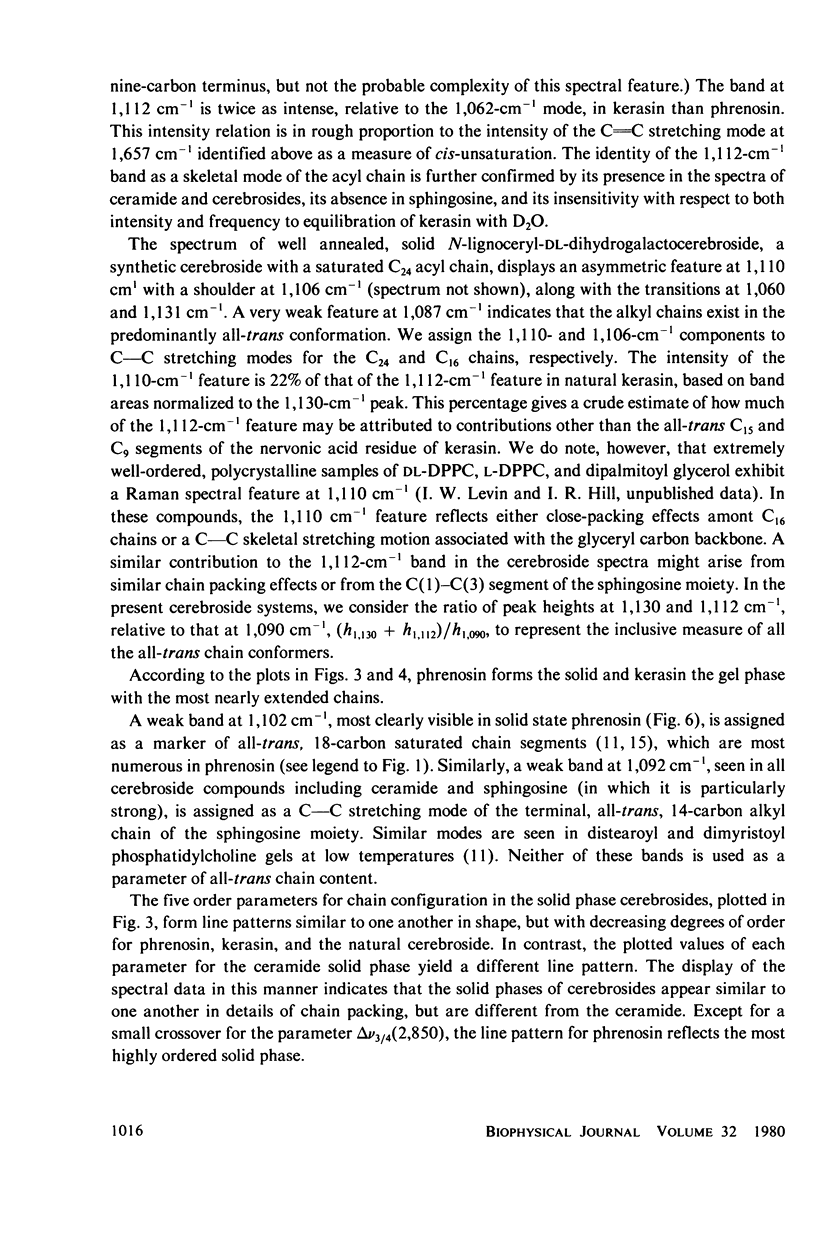Abstract
Vibrational Raman spectra of the solid and gel phases of bovine brain cerebrosides and the component fractions, kerasin and phrenosin, provide conformational information for these glycosphingolipids in bilayer systems. The carbon-carbon stretching mode profiles (1,150-1,000 cm-1) indicate that at 22 degrees C the alkyl chains assume an almost all-trans arrangement. These spectral data, combined with those from the C-H stretching region (3,050-2,800 cm-1), show that phrenosin forms the most highly ordered polycrystalline solid and kerasin the most ordered gel phase. The conformation of the unsaturated, 24-carbon acyl chains is monitored independently by a skeletal stretching mode at 1,112 cm-1. The alkyl chains in the kerasin and phrenosin gels are sufficiently extended to allow interdigitation of the 24-carbon acyl chains across the midplane of the bilayer. The amide I vibrational mode occurs at a lower frequency in solid phrenosin than kerasin, a shift consistent with stronger hydrogen bounding. This band is broadened and shifted to higher frequencies, however, in the phrenosin gel phase. In both the solid and gel phases natural cerebroside exhibits a composite amide I mode. The disruptive effects on cerebroside chain packing and headgroup orientation arising from mixing with dimyristoyl phosphatidylcholine are examined. Vibrational data for cerebroside are also compared to those for ceramide, sphingosine, and distearoyl phosphatidylcholine structures. Spectral interpretations are discussed in terms of calorimetric and X-ray structural data.
Full text
PDF














Selected References
These references are in PubMed. This may not be the complete list of references from this article.
- Acher A. J., Kanfer J. N. A method for fractionation of cerebrosides into classes with different fatty acid compositions. J Lipid Res. 1972 Jan;13(1):139–142. [PubMed] [Google Scholar]
- Bunow M. R., Levin I. W. Comment on the carbon-hydrogen stretching region of vibrational Raman spectra of phospholipids. Biochim Biophys Acta. 1977 May 25;487(2):388–394. doi: 10.1016/0005-2760(77)90015-7. [DOI] [PubMed] [Google Scholar]
- Bunow M. R. Two gel states of cerebrosides. Calorimetric and Raman spectroscopic evidence. Biochim Biophys Acta. 1979 Sep 28;574(3):542–546. doi: 10.1016/0005-2760(79)90250-9. [DOI] [PubMed] [Google Scholar]
- DeVries G. H., Norton W. T. The fatty acid composition of sphingolipids from bovine CNS axons and myelin. J Neurochem. 1974 Feb;22(2):251–257. doi: 10.1111/j.1471-4159.1974.tb11587.x. [DOI] [PubMed] [Google Scholar]
- Gaber B. P., Peticolas W. L. On the quantitative interpretation of biomembrane structure by Raman spectroscopy. Biochim Biophys Acta. 1977 Mar 1;465(2):260–274. doi: 10.1016/0005-2736(77)90078-5. [DOI] [PubMed] [Google Scholar]
- KISHIMOTO Y., RADIN N. S. STRUCTURES OF THE ESTER-LINKED MONO- AND DIUNSATURATED FATTY ACIDS OF PIG BRAIN. J Lipid Res. 1964 Jan;5:98–102. [PubMed] [Google Scholar]
- Larsson D., Karlsson D. A. Molecular arrangements in glycosphingolipids. Chem Phys Lipids. 1972 Mar;8(2):152–179. doi: 10.1016/0009-3084(72)90027-8. [DOI] [PubMed] [Google Scholar]
- Lippert J. L., Peticolas W. L. Raman active vibrations in long-chain fatty acids and phospholipid sonicates. Biochim Biophys Acta. 1972 Sep 1;282(1):8–17. doi: 10.1016/0005-2736(72)90306-9. [DOI] [PubMed] [Google Scholar]
- O'Brien J. S., Rouser G. The fatty acid composition of brain sphingolipids: sphingomyelin, ceramide, cerebroside, and cerebroside sulfate. J Lipid Res. 1964 Jul;5(3):339–342. [PubMed] [Google Scholar]
- Schmidt C. F., Barenholz Y., Huang C., Thompson T. E. Monolayer coupling in sphingomyelin bilayer systems. Nature. 1978 Feb 23;271(5647):775–777. doi: 10.1038/271775a0. [DOI] [PubMed] [Google Scholar]
- Träuble H. Phase transitions in lipids. Biomembranes. 1972;3:197–227. doi: 10.1007/978-1-4684-0961-1_14. [DOI] [PubMed] [Google Scholar]
- Yellin N., Levin I. W. Hydrocarbon chain disorder in lipid bilayers. Temperature dependent Raman spectra of 1,2-diacyl phosphatidylcholine-water gels. Biochim Biophys Acta. 1977 Nov 24;489(2):177–190. doi: 10.1016/0005-2760(77)90137-0. [DOI] [PubMed] [Google Scholar]
- Yellin N., Levin I. W. Hydrocarbon trans-gauche isomerization in phospholipid bilayer gel assemblies. Biochemistry. 1977 Feb 22;16(4):642–647. doi: 10.1021/bi00623a014. [DOI] [PubMed] [Google Scholar]


